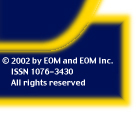| Table of Contents
November 1996
Volume 5, Number 11 Satellite Data/Aerial Photo/GPS: Integrating Flood Response in the Pacific Northwest
State and federal agencies, along with local govenments, employ RADARSAT aerial videography and GPS to aid in disaster response.
By Charles L. Rosenfeld, Greg G. Gaston and Monte L. Pearson Satellite Remote Sensing: Through the Looking Glass, Part 2
The remote sensing industry is getting in touch with the end user community. If further improvements are made, we should be in good shape to enter the age of high resolution.
By Mary Jo Wagner High Resolution Data Presents New Possibilities
With the lanches of several commercial very high resolution satellites on the horizon, space-based imagery is being seen as a new GIS mapping tool.
By Steven D. Hamilton GIS: Nomenclature for Open GIS
Open GIS specification will enable interoperability within and between image and vector worlds.
By Dr. Marshall Faintich Staying on the Map Without Losing Any Ground
By updating its GIS, the Arkansas Department of Health has eliminated the need for a full-time programmer and simplified day to day operations.
By Karen Howard Unmasking Nine Hidden Budget Busters in Your GIS Project
By Nirav Shah GPS: GPS Q&A: Industry experts answer reader's GPS questions
Airborne/ GPS Integration: Scrammbled Signals
An airborne GPS project near Las Vegas succeeds in spite of signal interference.
By Ruth Carapella
HOME | Back to Archives | 



